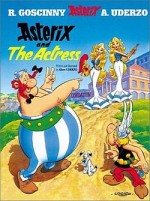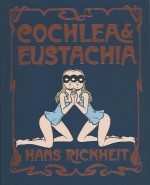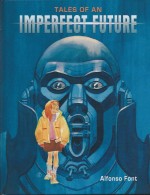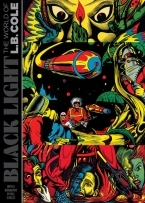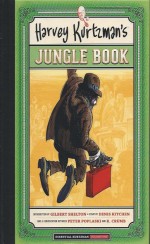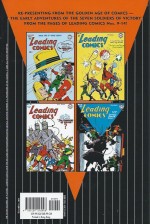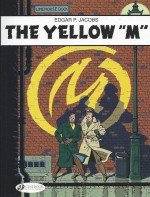
By Edgar P. Jacobs, translated by Clarence E. Holland (Cinebook)
ISBN: 978-1-905460-21-2
Master storyteller Edgar P. Jacobs pitted his distinguished duo of Scientific Adventurers Captain Francis Blake and Professor Philip Mortimer against a wide variety of perils and menaces in stunning action thrillers which merged science fiction, detective mysteries and supernatural thrillers in the same timeless Ligne claire style which had done so much to make intrepid boy reporter Tintin a global sensation.
The strip debuted in Le Journal de Tintin #1 (26th September 1946): an anthology comic with editions in Belgium, France and Holland. The new anthology was edited by Hergé, with his eponymous star ably supplemented by a host of new heroes and features…
Le Marque Jaune was the third astounding exploit of the peerless pair, originally serialised in Le Journal de Tintin from August 6th 1953 to November 3rd 1954, before being collected as the sixth drama-drenched album in 1956.
This moody stand-alone extravaganza is the first in the modern Cinebook sequence with the True Brits for once on home soil as they struggle to solve an eerie mystery and capture an apparently superhuman criminal…
The tale begins a few days before Christmas on a night raining cats and dogs. The guards at the Tower of London are dutifully going about their appointed tasks when a sudden power cut douses all the lights.
By the time Beefeaters and Yeomen can find alternative lighting the damage is done. The Jewel Room is ransacked, the Imperial Crown missing and the wall emblazoned with a large letter M in a bold circle of yellow chalk.
The shocking travesty is but the latest in an outrageous series of incredible crimes by someone the newspapers have taken to calling The Yellow M…
Incensed by the latest outrage the Home Office assigns MI6 to the case and their top man Blake is seconded to assist Chief Inspector Glenn Kendall of Scotland Yard. So serious is the matter that Blake instantly cables his old comrade Professor Mortimer, dragging the bellicose boffin back from a well-deserved vacation in Scotland.
London is ablaze with rumour and speculation about the super-bandit. The old warhorses adjourn to the Centaur Club in Piccadilly to discuss events but as they settle in for a chinwag, Mortimer gets a fleeting impression that they are being spied upon…
Suddenly they are interrupted by four fellow members also hotly debating the case. Sir Hugh Calvin is a judge at the Central Criminal Court; Leslie Macomber edits the Daily Mail and Professor Robert Vernay is a prominent figure in the British Medical Association and they all are hotly disputing Dr Jonathan Septimus – of the Psychiatric Institute – who propounds a theory that the phantom felon is a prime example of his pet theory of “The Evil Influence of Cellular Developmentâ€â€¦
The enlarged group continues the verbal back-and-forth into the small hours and when they finally break up Vernay follows his habit of walking home. He does not make it. The police find only his hat and a chalked letter in a circle…
The flamboyant rogue seems to be everywhere. When Blake and Mortimer interview Macomber, Calvin and the terrified Septimus next day, the invisible enigma somehow gets close enough to leave his mark on the MI6 officer’s coat, before sending a mocking cable warning the Mail’s Editor that more and worse is coming…
That night Macomber is abducted from his office in plain view of his staff and Kendall is found in a dazed state after failing to protect Judge Calvin from a mystery intruder…
Septimus concludes that he is next and convinces Blake to get him out of London. The pair board a train for Suffolk with a complement of detectives but even these precautions are not enough. The psychiatrist is impossibly plucked from the Express before it is wrecked in a horrific collision with another train.
In London, cerebral Mortimer has been researching another angle with the assistance of Daily Mail archivist Mr. Stone and has found a decades-old link between the missing men…
It all revolves around a controversial medical text entitled “The Mega Wave†and a scandalous court case, but when the Professor tries to secure a copy of the incredibly rare volume from the British Museum Library he is confounded by the Yellow M who invisibly purloins the last known copy in existence…
That evening he shares his thoughts with the returned Blake, unaware that his house has been bugged. Hours later a mysterious cloaked intruder breaks in but has a fit after passing some of Mortimer’s Egyptian souvenirs. The noise arouses the household and the masked burglar is confronted by Blake, Mortimer and burly manservant Nasir.
Incredibly the villain defeats them all with incredible strength and electrical shocks, even shrugging off bullets when they shoot him…
Exploding through a second story window the M laughs maniacally as they continue futilely firing before running off into the London night. In their shock the adventurers return to the drawing room and trip over the intruder’s listening devices…
Later the recovered Kendall visits just as a package arrives. It contains an anonymous note from someone wishing to share information and directs Blake to a late night rendezvous at Limehouse Dock. The message also contains a desperate note from the missing Septimus begging Blake to comply…
Well aware that it’s a trap and over Mortimer’s strenuous protests, Blake and Kendall lay plans to turn the meeting to their advantage. Left at home the Professor is surprised by a late visit from Stone. The remarkably efficient researcher has found a copy of The Mega Wave and rushed over to show Mortimer.
As Blake manfully braves the foggy waterfront and walks into deadly danger Mortimer is reading the tome, deducing who is behind the plot and perhaps even how the malign miracles are pulled off…
In Limehouse the empty commercial buildings become a spectacular battleground as Blake and the police confront the masked man who easily holds them all at bay with incredible feats of speed and strength, before breaking out of the supposedly impenetrable blue cordon and escaping.
In his destructive flight he tumbles into the frantic Mortimer who is dashing in to warn his old friend. Changing tack, the boffin gives chase, doggedly following the superhuman enigma through parks and sewers until he finds himself in a hidden basement laboratory being assaulted by mind-control devices devised by the sinister mastermind actually behind the entire campaign of vengeance and terror…
As the smirking villain gives an exultant speech of explanation, triumph and justification, Mortimer sees the fate of the abducted men and meets the human guinea pig who has been terrorising London at the behest of a madman. It is the very last person he ever expected to see again, but as he reels in shock Blake and Kendall are on his trail, thanks to the efforts of an avaricious cabbie with a good memory for faces…
As Christmas Day dawns Blake and Kendall lead a raid on the hidden citadel to rescue Mortimer, but the wily savant has already taken dramatic steps to secure his own release and defeat his insane, implacable opponent…
Fast-paced, action-packed, wry and magnificently eerie, this fabulously retro thriller is an intoxicating moody mystery and a sheer delight for lovers of fantastic fiction. Blake & Mortimer are the graphic personification of the Bulldog Spirit and worthy successors to the likes of Sherlock Holmes, Allan Quatermain, Professor Challenger, Richard Hannay and all the other valiant stalwarts of lost Albion…
In 1986 this story was reformatted and repackaged in a super-sized English translation, the last of six volumes with additional material (mostly covers from the weekly Tintin added to the story as splash pages) as part of a European push to win some of the lucrative Tintin and Asterix market here, but failed to find an audience. There were no more translations until January 2007 when Cinebook released this tome to far greater approval and much success…
Gripping and fantastic in the truest tradition of pulp sci-fi and Boy’s Own Adventures, Blake and Mortimer are the very epitome of dogged heroic determination; always delivering grand, old-fashioned Blood-&-Thunder thrills and spills in timeless fashion and with astonishing visual punch. Any kid able to suspend modern mores and cultural disbelief (call it alternate earth history or bakelite-punk if you want) will experience the adventure of their lives… and so will their children.
This Cinebook edition also includes a selection of colour cover sketches and roughs plus a biographical feature and chronological publication chart of Jacobs’ and his successors’ efforts.
Original editions © Editions Blake & Mortimer/Studio Jacobs (Dargaud-Lombard s.a.) 1987 by E.P. Jacobs. All rights reserved. English translation © 2007 Cinebook Ltd.


